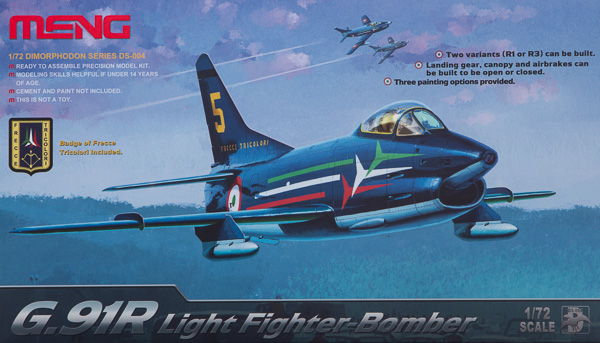
Meng 1/72 Fiat G.91R Gina Light Fighter Bomber
By Chris Banyai-Riepl
Overview
The Fiat G.91 derived from a NATO need for a small, inexpensive fighter bomber aircraft that could be built in great numbers and thusly dispersed throughout Europe. That greater dispersal gave a greater chance to survival following an initial nuclear attack, and after a short competition, the G.91 was selected for the air forces of Germany, Italy, and Portugal. The G.91 entered service in 1961 with Italy, and production continued until 1977, with the lines closing after producing well over 700 aircraft. The G.91 remained in Italian service until 1995, while in West German service it was replaced by the Alpha Jet in the early 1980s. Portugal's G.91s were the only ones to see combat, engaging in several conflicts in Africa. The Portuguese G.91s were phased out by 1993.
The Kit
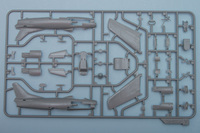 Following so quickly on the heels of their superb 1/72 F-102, the Meng 1/72 G.91 caught a lot of modelers by surprise. Many thought they would follow up the F-102 with more US aircraft types, so the little G.91 was a bit of a bombshell, and really makes figuring out what Meng will do next quite challenging (and a bit exciting, given the quality). The kit comes molded in the usual gray plastic, with surface detailing rivaling that of Hasegawa. Recessed panel lines are present throughout, and there are separate pieces to build two variants of the G.91.
Following so quickly on the heels of their superb 1/72 F-102, the Meng 1/72 G.91 caught a lot of modelers by surprise. Many thought they would follow up the F-102 with more US aircraft types, so the little G.91 was a bit of a bombshell, and really makes figuring out what Meng will do next quite challenging (and a bit exciting, given the quality). The kit comes molded in the usual gray plastic, with surface detailing rivaling that of Hasegawa. Recessed panel lines are present throughout, and there are separate pieces to build two variants of the G.91.
Like most aircraft, construction begins with the cockpit. This is made up from a one-piece tub that features nice molded-in detailing for the sidewalls. The instrument panel also features raised detailing, although not as prominent as the sidewalls. The seat is separate, and this is really the only big letdown in the kit. It is a very basic shape that barely resembles the Martin Baker ejection seat that should be in there. It has no harness provided, and there is a rather prominent ejector pin mark in the middle of the seat back. This really cries out for replacement with a resin seat.
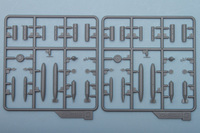 With the cockpit tub done, attention turns to all the bits and pieces that get sandwiched between the fuselage halves. There is an intake blanking plug fairly close to the intake opening (no full-length trunking here), and the nose gear well and main gear well are separate inserts. With the cockpit tub in place, the only other bit for the fuselage is the exhaust pipe, and then the fuselage can be closed up. With the fuselage together, the intake lip can be added and the two scoops on the lower nose.
With the cockpit tub done, attention turns to all the bits and pieces that get sandwiched between the fuselage halves. There is an intake blanking plug fairly close to the intake opening (no full-length trunking here), and the nose gear well and main gear well are separate inserts. With the cockpit tub in place, the only other bit for the fuselage is the exhaust pipe, and then the fuselage can be closed up. With the fuselage together, the intake lip can be added and the two scoops on the lower nose.
For the remaining fuselage bits, the nose cone is separate and molded solid. This is a minor issue, as it means that the camera ports are also solid plastic. This part probably would have been better molded in clear, leaving it up to the modeler to either mask the windows or just paint over them. The other main fuselage parts are the side gun panels, which provide the main visual difference for the variants. The G.91R/3 had two 20mm cannons, while the G.91R/1 and R/4 had four 12.7mm machine guns. These panels fit into openings in the fuselage halves. With the fuselage completed, you can add the solid wings and tailplanes, and the rest of the assembly is in the details.
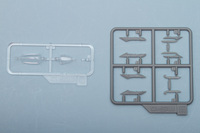 The details include lots of bits and pieces on the underside. The landing gear and air brakes can be displayed up or down. For displaying gear up, be ready to remove some locating tabs, but with the gear up, the clean lines of the G.91R really become apparent. For most of us, though, we'll want to have it on its legs, and the landing gear, while somewhat basic, does a good job of capturing the sturdy look of the G.91 legs. The air brakes come with separate actuator arms, and these often appear down when the plane is on the ground. The wings get separate fences and pylons for the various weapons provided, which are fairly thorough. In addition to the two fuel tanks (a ubiquitous sight on the G.91) the kit comes with two M64 bombs, two LAU-51 rocket launchers, two LAU-32 rocket launchers, and two LAU-3 rocket launchers.
The details include lots of bits and pieces on the underside. The landing gear and air brakes can be displayed up or down. For displaying gear up, be ready to remove some locating tabs, but with the gear up, the clean lines of the G.91R really become apparent. For most of us, though, we'll want to have it on its legs, and the landing gear, while somewhat basic, does a good job of capturing the sturdy look of the G.91 legs. The air brakes come with separate actuator arms, and these often appear down when the plane is on the ground. The wings get separate fences and pylons for the various weapons provided, which are fairly thorough. In addition to the two fuel tanks (a ubiquitous sight on the G.91) the kit comes with two M64 bombs, two LAU-51 rocket launchers, two LAU-32 rocket launchers, and two LAU-3 rocket launchers.
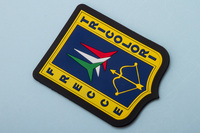 The marking options offer up a trio of interesting schemes. The first is the colorful aerobatic team Frecce Tricolori, which features a mostly blue aircraft with a silver fuselage belly and the Italian colors of green, white, and red on the lower wings and lower tailplanes. Most of the Frecce Tricolori aircraft were actually pre-production G.91s, which were distinguishable by the non-reconnaissance pointed nose. Aircraft #5, though, was apparently a replacement and was a stock G.91R/1. As an added bonus, the box includes a rubberized Frecce Tricolori patch, ready to Velcro on to your flight suit.
The marking options offer up a trio of interesting schemes. The first is the colorful aerobatic team Frecce Tricolori, which features a mostly blue aircraft with a silver fuselage belly and the Italian colors of green, white, and red on the lower wings and lower tailplanes. Most of the Frecce Tricolori aircraft were actually pre-production G.91s, which were distinguishable by the non-reconnaissance pointed nose. Aircraft #5, though, was apparently a replacement and was a stock G.91R/1. As an added bonus, the box includes a rubberized Frecce Tricolori patch, ready to Velcro on to your flight suit.
Also a G.91R/1 was the sole US Army aircraft, which was sent to the US for evaluation. This plane is finished in the standard Italian camouflage of green and gray, but featured extensive areas of high visibility orange on the tail, nose, wings, and fuel tanks. The aircraft had large ARMY titles on the fuselage and carried the star and bar in the usual spots.
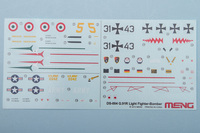 Finally we have a West German G.91R/3, camouflaged in the standard dark green and dark gray over medium gray. The German G.91s were armed with the 20mm cannons, and to help accentuate that, this scheme has a large sharkmouth that features the cannon barrel running down the open mouth. Where an eye would appear in the scheme, the large LeKG 41 unit emblem is painted instead. This particular aircraft took part in the "Bulls Eye '79" event, and features that emblem on the tail. The fuel tanks have an orange band, a common sight on German G.91s.
Finally we have a West German G.91R/3, camouflaged in the standard dark green and dark gray over medium gray. The German G.91s were armed with the 20mm cannons, and to help accentuate that, this scheme has a large sharkmouth that features the cannon barrel running down the open mouth. Where an eye would appear in the scheme, the large LeKG 41 unit emblem is painted instead. This particular aircraft took part in the "Bulls Eye '79" event, and features that emblem on the tail. The fuel tanks have an orange band, a common sight on German G.91s.
Conclusion
This is a great addition to the Meng product line, and a welcome addition to the 1/72 model range as the prior kits (Airfix and Revell) left a lot to be desired. Undoubtedly we will see some great aftermarket decals for this one before too long, including some of the dramatic special schemes the G.91 wore over the years. My thanks to Stevens International for the review sample.
